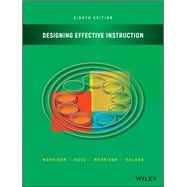A guide to the information and practical skills for successful instructional design, revised and updated
The updated eighth edition of Designing Effective Instruction offers educators an essential guide for designing effective and efficient instruction that is exciting and interesting. The flexible model presented is based on research from many different disciplines. The authors—noted experts on the topic—draw on recent research that incorporates both behavioral and cognitive approaches into the model.
The eighth edition highlights the fundamentals of instructional design that can help students develop a solid foundation in the design process. These basic skills can be adapted to a wide variety of settings, such as multimedia, classroom, business, health care, higher education, and distance-education instruction. This new edition has been revised to include information on the most recent research and trends. The book also contains a new section on the topic of lean instructional design. This new section discusses strategies to reduce time and resources for each step of the process. This important guide:
- Offers a review of the basic skills needed to create effective instruction
- Includes various features to stimulate thinking and provides additional explanations
- Provides a real-world scenario in every chapter
- Presents exercises to test skills and knowledge
- Contains a quality management section to help conduct a quick quality check of the design project
Written for instructional designers in business, military, medical, and government settings as well as to those in higher education and P–12 classrooms, Designing Effective Instruction is the proven resource for designing quality instruction that can motivate participants.









